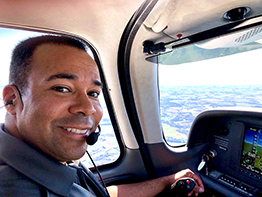by Michael Johnson
Business Process Manager
MnDOT Office of Aeronautics
Published in Midwest Flyer Magazine August/September 2021 online issue

The Minnesota Department of Transportation’s Office of Aeronautics is developing an air mobility strategic plan to prepare for Minnesota’s future as aviation technology evolves. The new Air Mobility Strategic Plan will lay out a framework for open decision-making that provides and supports coordination, collaboration and innovation, as well as ensures efficient and effective use of state resources.
As part of creating this new strategic plan, MnDOT is forming an Air Transportation Workgroup. The group is intended to help inform Minnesotans on the current state of the industry and engage the public and interested stakeholders in discussions of regulatory and standards-development activities at the federal, state and local levels. This new workgroup will also help MnDOT make informed transportation system decisions through an inclusive and engaging process, supported by data and analysis. More information about opportunities to participate in MnDOT Air Transportation Workgroups will be available in the coming months on the MnDOT website. If you have ideas for the workgroup or would like to become a potential member of the workgroup, please contact MnDOT at DroneInfo.DOT@state.mn.us, and watch for more information at www.mndot.gov/aero/drones.
Why a strategic plan? Why now?
Rapidly emerging aviation technology, along with evolving FAA rules that support use of that technology, are driving industry change at a disruptive rate. The technology isn’t just in development…in some instances it is here. For example, drone delivery is already occurring in six states, and major corporations like Amazon and UPS are working to adopt and deploy drone delivery technologies. Midsize electric propulsion aircraft capable of transporting people are in various stages of development and testing, with prototypes already operational.
Leveraging the capabilities of Unmanned Aircraft Systems (UAS) has the potential to change how Minnesotans conduct business, move goods, and access the nation’s airspace. It’s conceivable that UAS could soon provide rapid transport of life-saving medical supplies, delivery of food and other essentials, delivery of consumer goods, and efficiencies across warehouse and campus systems.
Beyond UAS, electric propulsion is now in the early stages of being applied to larger aircraft capable of carrying passengers. Electric and hybrid-electric regional passenger and cargo aircraft show promise to open commercial air travel and air freight delivery to previously underserved or unserved communities.
One of the key assumptions of MnDOT’s Air Mobility Strategic Plan is that the convergence of traditional multimodal transportation, with these more widely accessible forms of aviation, will drive a change in the way we think about aviation and integrated transportation. For example, Advanced Air Mobility has the potential to radically change urban, suburban, and inter-airport mobility through a network of electric Vertical Takeoff and Landing (eVTOL) aircraft.
As eVTOL and other technology-driven aviation changes become adopted, our traditional aviation system must adapt to support the future of aviation. A few considerations include vertiport location and design, aviation ecosystem infrastructure, new discussions around privacy and land use, workforce development, and economic impact.
The FAA continues to develop new regulations to fully integrate UAS into the nation’s airspace. It is important to recognize that UAS is not limited to the aircraft alone. UAS includes all of the components necessary to support the aerial operation, such as support equipment and controls, and the human operator.
One fundamental question is: where are these new aircraft going to take-off and land?
There are 113 heliports in Minnesota today. None of those are open to public use, and none support refueling. Nationwide, there are 5,918 heliports in the U.S. today. Yet only 58 are open to public use, and approximately 90 percent do not support refueling or other services. So, this is not just a Minnesota issue.
While the FAA provides design recommendations, the specifications are only required if the heliport receives federal grants through the Airport Improvement Program. Only one heliport in the U.S. has ever used AIP funding for construction (Indianapolis Downtown Heliport).
Also, many of the nation’s heliports are currently located in highly desired urban locations but are inactive due to local ordinances on noise levels.
Ideas for locating new vertiports include repurposed tops of parking garages, existing helipads, and underutilized land surrounding highway interchanges. While these options could, potentially, form the basis of an extensive, distributed network of vertiports, consideration must also be given to land use requirements, infrastructure requirements, and community input.
The Air Mobility Strategic Plan is an important part of providing statewide leadership and a shared vision and strategy for enabling safe, fast, and reliable air transportation for the citizens and businesses of Minnesota through partnership and innovation. Balancing technology capabilities with strategic planning will offer exciting new passenger and air transportation options for cities throughout Minnesota. While these new technologies continue to be refined and developed by private industry over the next several years, MnDOT’s statewide leadership will promote a shared vision and strategy to enable safe, fast, and reliable air transportation that benefits the citizens and businesses of Minnesota through planning, partnership, innovation and engagement.
Although the future is unknown, MnDOT’s Air Mobility Strategic Plan is an important step in helping us prepare for an unknown future by informing policy development, fostering innovation, creating an environment of inclusion, and promoting local and regional aviation ecosystems for deployment.